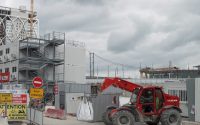Two Deadly Fires in Rapid Succession Expose India’s Gaps in Safety
Seven newborn babies lost their lives after their New Delhi neonatal clinic was engulfed in flames. What remained of the two-story building on Sunday morning was its burned facade, a charred spiral staircase and oxygen cylinders covered in soot.
Hours earlier, in the western Indian city of Rajkot, an amusement park of trampolines and bowling lanes had turned to an inferno. The families of people who had come to enjoy a discounted offer of all-you-can-play to celebrate the start of summer vacation were left trying to identify bodies among the at least 27 dead, many of them children too charred to be recognizable.
As after every such deadly episode, political leaders were quick with messages of condolence, announcements of arrests, creations of inquiries — and finger-pointing. But to analysts and experts who had warned for years about India’s abysmal fire preparedness, the back-to-back disasters on Saturday were the latest reminder that systemic change to make the country safer was still missing.
Building safety compliance remains abysmal across India, the world’s most populous nation. The fire services have long faced huge gaps in the numbers of stations, personnel and equipment. Government audits after mass-casualty disasters unearth glaring shortcomings, with little follow-up.
Though the number has gone down over the past decade, more than 20 fire-related deaths occur every day in India, according to government statistics. Many of the fires — particularly in crowded urban centers — are caused by short circuits, an alarming prospect as India faces an intense period of heat waves that strains electrical wires.
R.C. Sharma, a former fire service chief in Delhi, said that one major problem is that fire regulations go unenforced. Another is that fire-response resources have failed to keep up with urbanization that is happening rapidly and often without regard to safety.
“We are not in a good condition,” Mr. Sharma said. “In other countries, you have fire hydrants and everything at all the places. But in India, we don’t even have drinking water around the clock, so we do not think of having firefighting water around the clock.”
Data provided to the Indian Parliament in 2019 by the country’s Home Ministry painted a dire state of preparedness, with major deficiencies. India had only 3,377 fire stations when regulations called for 8,559. The shortfall in personnel and equipment was even worse. The fire service had about 55,000 people, when a half-million were called for, and 7,300 vehicles, when it should have had 33,000.
It is unclear how much of those gaps have been filled in the five years since. A new $600 million program for expansion and modernization of the fire service announced by India’s central government last year, with additional resources to be pooled from the states, suggests a lot of it remains undone.
Government audits have repeatedly flagged the vulnerability of public buildings, particularly hospitals.
A study last year of hospitals across India where there had been a fire in the past decade showed that half were not legally compliant on safety measures. Private and public hospitals were about equally bad. Short circuits were the cause of the fires in nearly 90 percent of the episodes.
In one state, after a fire killed 10 babies in a neonatal care unit, assessments found that more than 80 percent of the state’s hospitals had never carried out fire safety audits; half had never conducted fire drills; and only a few had fire safety certificates.
“The tendency is to comply in letter, not spirit,” said S.A. Abbasi, an emeritus professor at Pondicherry University, who was the lead author of the report. “Lapses and laxity continue to be the norms rather than exceptions.”
What caused the fire at the amusement park in Rajkot, in the state of Gujarat, was not known. But the initial police complaint, a copy of which was seen by The New York Times, made clear that the facility lacked both a clearance certificate from the fire department and effective equipment and protocols in case of fire.
Ilesh Kher, Rajkot’s chief fire officer, said the fire at the facility had started just before 6 p.m., and the flames were contained in a little over an hour. He did not know how many people were present when the blaze broke out, but witness accounts in local news suggested over 100.
The building appeared to be a temporary structure made of iron poles and metal sheets.
Daksh Kujadia, a teenager who had gone bowling with a cousin, said the fire had started under an emergency exit. About 30 people became trapped in the bowling lanes.
“We didn’t have an option but to tear the metal sheet in a corner,” he told local news media. “Fifteen of us got out by jumping from there.”
The two-story Delhi neonatal hospital that caught fire just before midnight was operating out of a residential building. Neighbors described frequent disputes, as trucks often blocked the road outside the hospital to unload large cylinders of oxygen.
“A few of us climbed on top of each other and climbed into the building from the back side,” said Ravi Gupta, who lives in the area and helped evacuate a dozen babies from the back of the building as the front caught fire and multiple explosions were heard as oxygen cylinders burst. “We brought ladders and bedsheets from our houses. I carried infants in my hands from the fire and brought them down.”
Health care in Delhi, India’s capital, has in recent years has been caught in a messy political fight between the central government of Prime Minister Narendra Modi and Delhi’s elected local government, run by a smaller opposition party, the Aam Aadmi Party, or A.A.P. The local administration has accused Mr. Modi of using his control over government officials to handicap its efforts.
Accusations continued to fly after Saturday’s deadly hospital fire.
Pankaj Luthra, a local official affiliated with Modi’s party in the neighborhood where the hospital is, blamed the A.A.P. for giving the hospital its license. There had been, he said, complaints of illegal oxygen cylinder refilling at the hospital.
Saurabh Bhardwaj, A.A.P.’s health minister for Delhi, released a statement complaining that the most senior official in Delhi’s health department — a civil servant technically supervised by Mr. Bhardwaj, but in fact answering to the central government — was ignoring his calls and messages.
“I got to know about this incident through a media flash,” Mr. Bhardwaj said.


